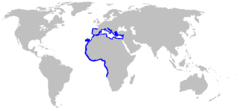Common torpedo
| Common torpedo | |
|---|---|
 |
|
| Scientific classification | |
| Kingdom: | Animalia |
| Phylum: | Chordata |
| Class: | Chondrichthyes |
| Subclass: | Elasmobranchii |
| Order: | Torpediniformes |
| Family: | Torpedinidae |
| Genus: | Torpedo |
| Species: | T. torpedo |
| Binomial name | |
|
Torpedo torpedo (Linnaeus, 1758) |
|
 |
|
| Range of the common torpedo | |
| Synonyms | |
|
Raja torpedo Linnaeus, 1758 |
|
Raja torpedo Linnaeus, 1758
Torpedo narke Delaroche, 1809
Torpedo ocellata Rafinesque, 1810
Torpedo oculata Davy, 1834
Torpedo unimaculata Risso, 1810
The common torpedo, ocellate torpedo, or eyed electric ray (Torpedo torpedo) is a species of electric ray in the family Torpedinidae, found in the Mediterranean Sea and the eastern Atlantic Ocean from the Bay of Biscay to Angola. It is a benthic fish typically encountered over soft substrates in fairly shallow, coastal waters. Growing to 60 cm (24 in) long, this species has a nearly circular pectoral fin disc and a short, thick tail with two dorsal fins of nearly equal size and a large caudal fin. It can be identified by the prominent blue spots on its back, which usually number five but may vary from zero to nine, as well as by the small knobs on the rims of its spiracles.
For attack and defense, the common torpedo can deliver a strong electric shock of up to 200 volts. It is a solitary, nocturnal ambush predator that feeds mainly on bony fishes and crustaceans. This species is aplacental viviparous, with the developing embryos nourished by yolk and histotroph ("uterine milk") produced by the mother. Females produce litters of up to 28 young every year in late summer or autumn, after a gestation period of 4–8 months; the specifics vary between geographical regions. The common torpedo's shock is painful but otherwise of little danger to humans. Its electrogenic properties led it to be used in medicine by the ancient Greeks and Romans. In modern times, it has no economic value and is mostly discarded when caught as bycatch in fisheries. The impact of fishing on its population is uncertain, and pending more data the International Union for Conservation of Nature (IUCN) has listed it as Data Deficient.
...
Wikipedia

